Features
To date, over 3.5 million people have died from Covid-19. Understanding its origins, with a view to preventing any future such pandemics, is therefore of global importance. Covid-19, known formally as SARS-CoV-2, is a coronavirus, and historically these have come to afflict humans through spill-over from wildlife sources. This was the case with the Middle East Respiratory Syndrome (MERS) outbreak in Jeddah, Saudi Arabia, in 2012, spilling-over from dromedary camels, killing 858 people; similarly the SARS-CoV epidemic (for which there is still no cure) that began in Guangdong in 2002 and killed 744 people, spilled-over from palm civets as an intermediary, transferring infection from cave-dwelling horseshoe bats.
We had been gathering data collected from across Wuhan’s wet markets…which put our team in the right place at the right time to document the wild animals sold in these markets in the lead up to the pandemic
Not surprisingly then, the finger of blame has been pointed at wildlife trade in the wet markets of Wuhan, Hubei, China, where this Covid-19 outbreak seems to have originated. Candidate species include bats, which are definitive hosts brewing coronaviruses, and both pangolins and palm civets as potential intermediaries; although the most recent genetic data suggest that the variant found in these latter species isn’t quite similar enough to the human variant to be a totally convincing source. Nevertheless, through 14th Jan to 10th Feb this year the World Health Organization (WHO) sent an investigative team to Wuhan, where part of their remit was to try to ascertain, post hoc, what animals were being sold in markets prior to closures. Their report was inconclusive, but drew attention to the particular need to monitor bat and pangolin trading.
Our investigation found that both bats and pangolins had an alibi – neither was there!
Working with our colleagues based at China West Normal University, Nanchong, and Hubei University of Traditional Chinese Medicine, Wuhan, Xiao Xiao and Zhao-Min Zhou on the ground in China, the WildCRU team had been gathering data collected from across Wuhan’s wet markets through May 2017 and November 2019. This research, begun before Covid-19 focused a spotlight on these markets, was actually motivated by a study of tick-borne (no human-to-human transmission) Severe Fever with Thrombocytopenia Syndrome, which put our team in the right place at the right time to document the wild animals sold in these markets in the lead up to the pandemic. Our investigation, published today in Nature-Scientific Reports, found that both bats and pangolins had an alibi – neither was there!
 Caged marmots above a cage containing hedgehogs, Huanan seafood market prior to closure
Caged marmots above a cage containing hedgehogs, Huanan seafood market prior to closureWith these huge concentrations of diverse species under one roof, while we discovered no evidence supporting original spill-over from candidate bats or pangolins in Wuhan, it would seem but a matter of time before some other unwelcome disease might skip into the human population. Indeed it is estimated that around 70% of all diseases afflicting people originate in animals, think Avian Influenza, HIV, Ebola, etc.
Commendably, with this risk in mind, on the 26th of Jan 2020, China’s Ministries temporarily banned all wildlife trade as a precautionary step until the COVID-19 pandemic concludes. Subsequently, on 24th Feb 2020, they permanently banned eating and trading terrestrial wild (non-livestock) animals for food. These interventions, intended to protect human health, redress previous trading and enforcement inconsistencies, will have collateral benefits for global biodiversity conservation and animal welfare, and will hopefully prevent some future tragedies.
Professor David Macdonald is Director of WildCRU, part of the Department of Zoology, University of Oxford
Genetics and genomics are increasingly in the news. People can buy genetic tests on the internet, without providing a medical reason or involving a health professional. But how useful is personal genetic health information, and are there any downsides to buying tests?
I am a researcher in the Radcliffe Department of Medicine at the University of Oxford, and a genetic counsellor working with patients with inherited cardiac disease and their families. I see at first hand the benefits of genetic testing in the NHS, but also the variety of questions people want to discuss before going ahead with a test.
Buying a ‘direct to consumer’; (DTC) genetic test is different from an NHS genetic test in many ways, so when the UK Parliament announced an inquiry into Commercial genomics in 2019, I submitted written evidence along with many health professionals and academics, commercial providers and other interested parties.
The ‘Research & Public Policy Partnership’ scheme opened in late 2019 and seemed a good opportunity to start to build a programme of research that would have policy input from the start, ensuring its relevance for policy. The University Policy Engagement Team suggested approaching Dr Peter Border at the Parliamentary Office of Science and Technology (POST). Together with a General Practice and ethicist colleague, Dr Andrew Papanikitas, we put together a proposal outlining how we would work together and what we wanted to achieve.
We wanted to consider a range of perspectives about three sources of personal genetic health information: the NHS... commercial genetic testing... and research testing
We had planned an event bringing together a range of stakeholders in April 2020 in Oxford, but due to the COVID 19 pandemic it was quickly clear that could not happen. Pivoting quickly, one of our first spends was a subscription to an online meetings platform, and in fact the team has never met in person. We spent some time thinking about how we could adapt, and arrived at a plan to hold a series of online meetings with the people whose views we were interested in hearing.
We wanted to consider a range of perspectives about three sources of personal genetic health information: the NHS, which offers genetic testing to people with a rare disease or cancer and at risk relatives, commercial genetic testing which can be bought by anyone who has the financial means, and research testing.
We reached out to commercial providers, NHS professionals, genomic scientists, patient representatives, legal experts, charities funding medical research, and ethicists and other scholars with expert knowledge. Fortunately most people contacted agreed to take part; perhaps an advantage of the adapted setup meant that people could more easily commit to a shorter (90 minutes) meeting from home.
The meetings felt quite intense because we covered a lot of ground, but our mild worries that witnesses might clash were not realized – everyone was good-natured
All meetings were recorded and professionally transcribed. After each meeting the team analysed the transcript, met to discuss in depth and agree areas of further interest. This process allowed us to direct the next discussion, by posing key questions to one or two ‘witnesses’, and encouraging other witnesses to offer perspectives. The meetings felt quite intense because we covered a lot of ground, but our mild worries that witnesses might clash were not realized – everyone was good-natured.
Our learnings fed into a summary document for POST which contributed to the parliamentary inquiry.
We have successfully bid for more funding with an additional policy partner, Health Education England Genomics Education Programme to develop inclusion of ethical considerations, including those identified in our partnership, into health professional education.
Looking to the future, we will use what we’ve learned to articulate areas requiring further policy-directed research.
This has been a new way of working for Andrew, Peter and me. The practical issues raised by needing to work collaboratively yet remotely seemed very challenging at the start, but have perhaps been balanced by the advantages offered by setting up a structure for accessible meetings.
The three of us have very different professional backgrounds, and that has sometimes meant listening and adapting to unfamiliar ideas and ways of thinking. The content of the outputs we’ve generated is very different from those I had expected, and have highlighted new areas of interest for me. The new project is testament to the value we’ve derived from the partnership.
Dr Liz Ormondroyd is a BRC funded researcher based at the Radcliffe Department of Medicine. Her partnership with the Parliamentary Office of Science and Technology was funded by the University of Oxford Research & Public Policy Partnership Scheme.
By Dr Manuel Spitschan and Coline Weinzaepflen
We are very excited to share our new comic book "Enlighten Your Clock: How your body tells time". The main protagonist is a cat – a pet species notable for seemingly sleepy behaviour – guiding the human character. As the biological clock underlies many aspects of our physiology and behaviour, the book addresses a key need to explain how the environment impacts on our brain and our body.
We designed this book for teens and above who are curious about circadian rhythms, sleep, and the effects of light on our body and brain.
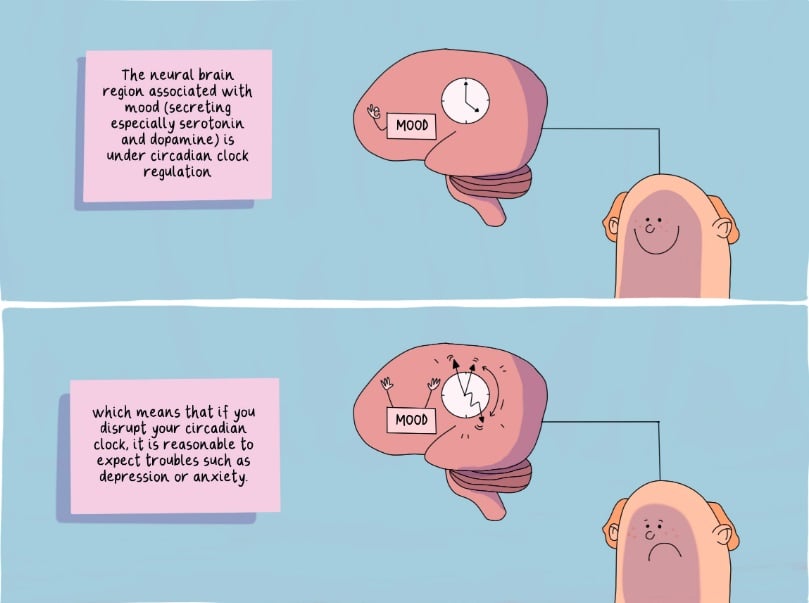
The editor - Dr Manuel Spitschan
In my research, I investigate how light helps us see and controls our biological clock. We’ve known for a while looking at a bright light at the wrong time - specifically in the evening and at night - can upset our circadian clock.
Over the past few years, the importance of a good night’s sleep has moved into the focus of many people’s attention, and it is something that might feel difficult to attain while a global pandemic is happening around us.
When Coline started her internship with me as part of her Master’s project, and I learned that she was an illustrator, I proposed the idea of a comic book to her.
I’ve always been fascinated by how to best communicate complex scientific messages to a clear message that is accessible but doesn’t “dumb down” the content. I hope the book becomes a valuable resource for teenagers, parents, teachers, and everyone interested in this topic across the UK and beyond.
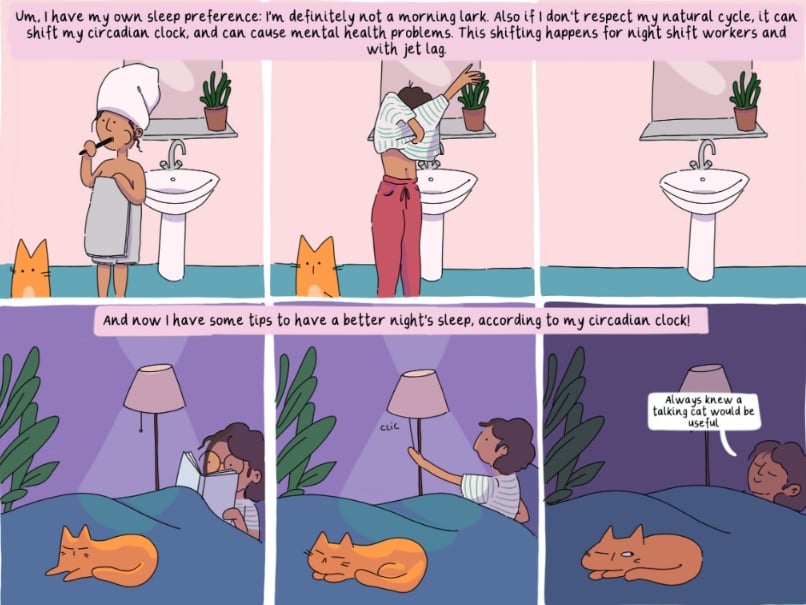
The writer and illustrator - Coline Weinzaepflen
I’ve always enjoyed making meaningful drawings in illustrations or comics. Making science accessible as much as possible to people can be a significant challenge for the scientific community.
That’s why I had a lot of enthusiasm working on this comic book. This project merged two things that I love: explaining biological concepts that I am fascinated by, and drawing (cat) cartoons.
The idea was to develop a format enjoyable for teenagers and adults, giving all the keys to understanding better sleep and what happens in their bodies and brains during the day and at night.
When I approached Manuel initially to do an internship in chronobiology, I had no idea that I would be able to combine these two interests of mine.
Making the comic book was exciting because we didn’t want something too complicated or too obvious. Part of the process involved the precious help of students from Cherwell School, who helped make the comic as accessible and engaging as possible.
I hope we’ve accomplished our mission: that this bit of science will enthral many people and hopefully give them the desire to know more!
Dr Manuel Spitschan, who wrote the comic book, is a University Research Lecturer, in the Department of Experimental Psychology, University of Oxford
Coline Weinzaepflen, who illustrated the comic book, is a neuroscience student and Illustrator
The comic book was developed within the Sleep, circadian rhythms and mental health in schools (SCRAMS) network, which Dr Spitschan is a member of, and was funded by an MRC/AHRC/ESRC Engagement Award in the Adolescence, Mental Health and the Developing Mind (MR/T046317/1: Sleep, circadian rhythms and mental health in schools (SCRAMS)).
The comic book (licensed under CC-BY-NC-ND license) is available for free as a PDF on https://enlightenyourclock.org/.
Cameron Hepburn is not an environmentalist from central casting. In person, Oxford’s professor of Environmental Economics comes across more like...well, an economist or a successful entrepreneur (he laughs), rather than a clichéd protestor, set on gluing himself to an inanimate object. But this is what makes him all the more convincing and persuasive. When he says, we need to take action now, the automatic response is: how not why.
The economist is under no illusion about the structural challenges and is sought out by governments around the world, looking to meet challenging Net Zero targets and ‘build back better’
As someone who has been at the cutting edge of environmental issues since the early 2000s, before the term ‘climate change’ was common currency, Professor Hepburn is insistent about the need to move away from a carbon-based economic model. But the economist is under no illusion about the structural challenges and is sought out by governments around the world, looking to meet challenging Net Zero targets and ‘build back better’.
The youthful professor is both reassuring and realistic, pointing out economic upheaval will take place over decades, as old industries are replaced by new jobs and, he maintains, technological change means the costs of conversion are coming down – a welcome thought for both countries and consumers.
Talking as the Government announces he is to lead a multi-million-pound project investigating greenhouse gas capture, Professor Hepburn is adamant the time is past for delay and that we now have to cut our carbon emissions, while actively removing greenhouse gases from the atmosphere.
It’s not an either-or-situation. We have to reduce emissions as fast as possible, and scale up our capacity to remove greenhouse gases from the atmosphere
Professor Cameron Hepburn
The ambitious project, announced today, encompasses leading environmental scientists at universities around the UK – and funds cutting-edge research into ways of removing the gases and storing them, permanently.
‘There’s a lot of very clever science underway in the UK and around the world,’ says Professor Hepburn. ‘Scientists have developed machines to capture carbon dioxide from the air and bury it underground. Others are restoring ecosystems to lock-up carbon in trees, plants, and soils. Still others are studying ways to accelerate the natural processes by which minerals in rocks absorb carbon dioxide from the air. ‘
‘It’s all incredibly interesting and potentially vital,’ he says.
It might seem a strange comment for someone who started their career working for Shell, the oil giant. But, says Professor Hepburn, his early encounter with fossil fuels convinced him that this was ‘even then a sunset industry’ and it began him on the road to his environmental work.
‘It’s important that we look at the societal impact as well as the political and structural impacts,' he says. ‘We have delayed for long enough, so that we have no choice but to explore ways to get greenhouse gases out of the atmosphere, which also help us achieve other social and environmental goals.’
Professor Hepburn heads the project’s Hub, which will coordinate the work, and look into ways of scaling up the research to economic viability, as well as making it possible in the political and legal framework. Oxford, and its partners at other universities, will provide the ‘central brain’, he says. His team will gather evidence, verify research and provide data.
The young Cameron lived with his parents and siblings in an idyllic environment in the Australian outback, with lots of camping expeditions and life in the outdoors. It sounds more Skippy than Crocodile Dundee
It was a path which began in the outback of Australia, where the young Cameron lived with his parents and siblings in an idyllic environment with lots of camping expeditions and life in the outdoors. It sounds more Skippy than Crocodile Dundee, with Mr Hepburn senior nicknamed ‘Leafy’ Leigh Hepburn because of his interest in nature.
Cameron won a scholarship to a school in Melbourne, where his fellow alumni include many leading Australians – including a host of army chiefs, bishops and...Barry Humphries (not a contemporary).

From there, he went to Melbourne University, where the young scholar was awarded degrees in Engineering and Law. But, after the brush with Shell and then some law firms, where he was engaged designing complex legal contracts for the financing of power plants, the graduate knew, ‘It was very clear that this was not how things should be done’.
Changing tack, he applied for a Rhodes scholarship to come to Oxford to take a masters in Economics. He intended to be in the UK for two years. Twenty one years later, now married with three children, he is still here, having taken a doctorate in Economics, become a researcher, then a senior researcher, now the Professor of Environmental Economics. Having changed track twice, he knew he did not want a conventional economics career.
‘Environmental economics was virtually invisible,’ he says. ‘I didn’t want to spend my time looking at the money supply...I was much more interested in thinking about the impact of climate change.’
Environmental economics was virtually invisible... I didn’t want to spend my time looking at the money supply...I was much more interested in thinking about the impact of climate change
Professor Hepburn
Laughing, he adds, ‘I thought it was worthy of a career – and so here I am.’
'Climate change was on the scientific agenda for decades before climate concerns became widespread and governments around the world were pledging to reduce emissions, and environmentalism became mainstream.'
He adds, 'It’s a shame Australia didn’t begin the transition [from a carbon-based economy] back in the 1990s. We could have done things more steadily. The later you leave it, the more difficult some things become, as they have to be done faster.’
But he says, ‘The good thing is, everyone has woken up. We have delayed long enough.’
There should be no need for mass redundancies, to meet the UN’s 2050 Net Zero target. Older industry jobs will be more than replaced by others – and it does not have to happen all at once
Professor Hepburn
However, Professor Hepburn does not underestimate the challenges and the costs of transitioning away from fossil fuels- and the need to reassure. He maintains there should be no need for mass redundancies, to meet the UN’s 2050 Net Zero target. Older industry jobs will be more than replaced by others – and it does not have to happen all at once.
While stressing there will be costs of going Net Zero for some countries, businesses and individuals, Professor Hepburn anticipates that new technologies will emerge and existing ones will become much cheaper. He says, ‘Smarter, cleaner tech is getting better and cheaper all the time...it won't be long before it would be crazy for anyone to buy a fossil fuel-driven car.’
He admits that domestic heating is a ‘big challenge’, with most UK homes reliant on fossil fuel energy. But he maintains, we will not be sitting at home shivering in 20 years. Technological progress is already happening which will assist in making the switch to clean heating cheaper. Overall, he thinks, the savings on cheaper electricity and transport will help offset the costs of investment on clean heating.
Smarter, cleaner tech is getting better and cheaper all the time...it won't be long before it would be crazy for anyone to buy a fossil fuel-driven car
Professor Hepburn
The same goes, he hopes, for air transport, with short-haul flights potentially driven by battery-powered electric motors, and longer haul adopting hydrogen and ammonia solutions.
According to Professor Hepburn, though, we do not need to wait for technology to start the process of improving sustainability. Nature based solutions can be deployed right now. ‘Leafy’ Leigh was right, it seems. Professor Hepburn says, ‘Trees are the oldest tech in the world....nature has been doing this [taking carbon out of the atmosphere] for millennia.’
He is optimistic about the future, despite the delays in getting started, and points to the fact that countries and businesses around the world have given Net Zero pledges, to slash emissions, which cover two thirds of international GDP. But will the fine words translate into action? Many critics focus on whether the ‘big polluters’ are going to take action and whether vested interests will take this lying down. Professor Hepburn stresses, ‘The credibility of such targets is vital.’
And he maintains key carbon emitters should accelerate towards Net Zero targets, as the technology becomes more affordable. But Professor Hepburn admits, ‘There will be winners and losers in the transition [think sunset industries]. It needs to be a just transition...but the transition will create many more jobs than it destroys. There will be net gains both to economies and workers.’
The reality of transition to sustainable power, like many new technologies in the past, will be far less difficult than is currently apparent
Professor Hepburn
As an economist, he points out, economies have transitioned all the time. When there has been seismic shifts in technology, they have adjusted naturally, ‘The economy can be quite flexible but we need transition schemes for reskilling.’
He adds, ‘It is critical that financial and economic ministries are looking at this – and they are.’
Reassuringly, says Professor Hepburn, the reality of transition to sustainable power, like many new technologies in the past, will be far less difficult than is currently apparent.
‘Clean electricity is already cheaper in a lot of parts of the world, solar and wind is cheaper and electric vehicles are simpler and easier to maintain.’
Who’d be a petrol-head? ‘Within a few decades, he wonders, I think we will look back at cars spewing out toxins into our lungs as even worse than horses defecating in the middle of our streets.’
And yet, and yet, what can the UK do, or other European countries, when we are not responsible for most of the world’s emissions? Professor Hepburn is typically enthusiastic: Britain has been leading on climate science for a decade
And yet, and yet, what can the UK do, or other European countries, since we are not responsible for most of the world’s emissions?
Professor Hepburn is typically enthusiastic, ‘Britain has been leading on climate science for a decade. The whole concept of Net Zero arguably came from Oxford, as did Net Zero investment finance and Net Zero economics.’
Pointing out the greenhouse gas project could deliver technology for the world, he insists, ‘These are ideas that matter, drivers of change. The UK is important for wider science and theories. It’s the first large country which had a formal architecture with the government's committee on climate change and the net zero legislation – it’s not just a theory for the UK.’
And, says Professor Hepburn, Oxford’s environment and structure has been key in propelling environmental research up the agenda.
‘It’s a pretty unique place,’ he says. ‘The college system means we meet people from other disciplines all the time [which facilitates and drives critical inter-disciplinary cooperation]. You can find yourself sitting next to a classicist or a specialist in Physics.’
Also, he says, the Oxford Martin School, the university’s multi-disciplinary research organisation, drives key research, involving experts from every discipline and has led to environmental collaboration on pressing international topics. And, he notes, that the Smith School, which he directs, has interdisciplinary research right at the heart of the mission.
While we stand on the cusp of massive change, Professor Hepburn says, he is hopeful, ‘2019 may have been the peak year for fossil fuels...the global community can no longer deny it makes sense to transition. Why sink more money into gas and coal, when the future is clean?’
See £30 million official backing for Oxford-led greenhouse gas removal programme | University of Oxford
Imagine saving a million lives. While the world was in the first throes of the pandemic and paralysed in the face of the seemingly unstoppable spread of the coronavirus, two Oxford professors, Peter Horby and Martin Landray, started a trial which is estimated to have saved around one million lives with a £5 medicine that is available across the world.
 In an interview for Science blog, Professor Landray explains that he mooted the idea on 28 Feburary 2020, in an email to Sir Jeremy Farrar, the head of Wellcome. A few days later, they discussed it on a No 18 bus to Marylebone. Sir Jeremy suggested he join forces with Professor Horby, an expert in infectious diseases and epidemiology and a nodding acquaintance from Oxford’s medical science community. And the rest really is history.
In an interview for Science blog, Professor Landray explains that he mooted the idea on 28 Feburary 2020, in an email to Sir Jeremy Farrar, the head of Wellcome. A few days later, they discussed it on a No 18 bus to Marylebone. Sir Jeremy suggested he join forces with Professor Horby, an expert in infectious diseases and epidemiology and a nodding acquaintance from Oxford’s medical science community. And the rest really is history.
Treatments for COVID-19 were urgently needed in early 2020, since there were no known treatments when the virus took hold. Oxford colleagues had quickly begun working on a vaccine, but Professor Landray, an expert in heart conditions and drugs trials, suggested that a trial be conducted with hospitalised patients to see if any existing medicines could be used in the fight against the worst effects of the virus. Speed was of the essence; treatments were needed rapidly whilst vaccines were being developed and rolled out – and they are still a crucial piece of the jigsaw needed to complement preventative measures and save lives.
Within days, with backing from Oxford colleagues, they had set up and gained approval for the ground-breaking RECOVERY trial. By 19 March, they had recruited their first participant. Three months later, they had found the first proven effective treatment.
Simplicity was the key, according to Professor Landray, ‘Patients were very sick and we couldn’t burden the NHS with demands on their time....a streamlined clinical trial which was integrated with clinical care was the only way.’
Within days...the pair had set up and gained approval for the ground-breaking RECOVERY trial. By 19 March, they had recruited their first participant. Three months later, they had found the first proven effective treatment.
So, clinicians were asked to enter basic patient details on the trial website and, initially, the system randomly allocated one of four carefully-chosen drugs, each offering the potential to tackle the disease, or no additional treatment alongside oxygen and ventilator treatments. It was a classic randomised controlled trial – including a control sample who received no additional treatment beyond the usual care in their hospital – but one which had not been used in such circumstances before.
The medical profession in the UK responded with alacrity and enthusiasm, eager to help beat the virus. More than 4,000 medical professionals in every acute NHS hospital in the country took part and nearly 40,000 patients have now been enlisted.

‘Many clinicians grabbed the opportunity to help find solutions to this crisis,’ says Professor Landray. ‘And we couldn’t have done it without their support.’
A triumph for collaboration and research, by mid-June, dexamethasone, a commonly-available steroid, was found to be effective in patients on ventilators and those receiving oxygen. ‘It had very clear benefits,’ says Professor Landray, remembering the excitement around the finding. ‘We’d never seen anything like it.’
Many clinicians grabbed the opportunity to help find solutions to this crisis...and we couldn’t have done it without their support
Professor Martin Landray
It was not a cure, but it prevented 30% of deaths and it quickly became standard care around the world – reversing previous thinking which had suggested that it shouldn’t be used because it was ineffective or might even be harmful. In early June, another drug, hydroxychloroquine, which had been hailed as a miracle cure, was found by the trial to be useless for hospitalised patients.
They announced the dexamethasone news at 1pm on 16 June 2020, says Professor Landray. He was still talking to the media at 11pm. Professor Horby travelled to No10 to present the news alongside the Prime Minister at a Government briefing.
‘He was wearing my tie as didn’t have one with him,’ laughs Professor Landray, who takes no chances. ‘I had brought in two.’
A triumph for collaboration and research, by mid-June, dexamethasone, a commonly-available steroid, was found to be effective in patients on ventilators and those receiving oxygen
As the Deputy Director of Oxford University’s Big Data Institute, Professor Landray knows about large numbers. He is delighted by the success of the trial, especially the key role played by doctors, nurses, and patients in hospitals from the Western Isles to Truro, but he says, ‘What matters is that in 100 days, with all the people involved in the trial, a treatment was found.’
It has been a stunning success, and the professors were last week honoured to be elected as fellows of the Academy of Medical Sciences, alongside a host of Oxford colleagues, for their exceptional contributions to the advancement of medical science, an accolade that recognises the impact of RECOVERY and the importance of their previous work.
The building which houses Oxford’s Big Data Institute and part of the Nuffield Department of Population Health exemplifies Professor Landray’s streamlined approach, which is not surprising, since he was involved in the design - very modern, with clean, geometric lines, light wood panels and open offices. In usual times, it is alive with 500 data scientists, ethicists, philosophers, and population health experts, all under one beautiful roof.
Professor Landray credits the strength of the medical community at Oxford for much of his success. ‘We are very fortunate in Oxford. There is huge strength and depth. There are the people at Oxford who have written landmark papers, the headline people from conferences. I am very lucky to have had people to help, support and mentor me.’ He adds, ‘Richard Doll (the man credited with proving that smoking causes lung cancer) was here when I first moved to Oxford.’
There are the people at Oxford who have written landmark papers, the headline people from conferences. I am very lucky to have had people to help, support and mentor me
Professor Landray credits the strength of the medical community at Oxford
Professor Landray is an Oxfordshire local, who grew up and still lives in a village some half an hour’s drive from the city. He literally married the girl next door – although to be precise, of course, he says, ‘She lived about 50 yards away.’
Professor Landray knew early on that he wanted to be a doctor. ‘Medicine was all around us, my mother was a part-time anaesthetist, my father was the local GP – very much in the James Herriot style.’
Some of his earliest memories are of patients coming to the house and lying on the family sofa, so his father could examine them.
‘I never thought about doing anything else,’ says Professor Landray. Life as a local GP was not to be, though, since after medical school at Birmingham University, the young doctor never did take over from his father, becoming instead a clinical pharmacologist and heart specialist.
In fact, until the pandemic, he had not taken much of an interest in infections since 1980, when the young Martin wrote an article about germs for the local children’s newspaper. Clearly amused, he says, ‘It’s in the Bodleian, complete with a picture of a germ I drew myself. I didn’t publish another paper on infections until 2020.'
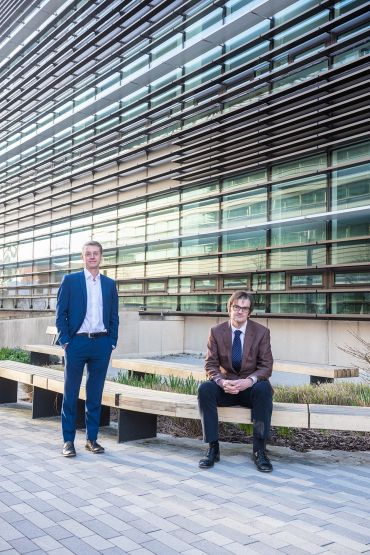 Professor Peter Horby (tieless) and Professor Martin Landray were last week honoured to be elected as fellows of the Academy of Medical Sciences.
Photo by John Cairns.
Professor Peter Horby (tieless) and Professor Martin Landray were last week honoured to be elected as fellows of the Academy of Medical Sciences.
Photo by John Cairns.He joined the group led by Professor Sir Rory Collins and Professor Sir Richard Peto, whose work on clinical trials for heart attack he had admired as a student.
‘I remember reading the results of their trial of aspirin and clot buster drugs for patients suffering a heart attack,’ he says of the Second International Study of Infarct Survival (known as ISIS-2). ‘It changed the treatment of heart attacks overnight.
‘It was so simple, so elegant, and so powerful.’
It made a massive impression on the young medic. Professor Landray’s enthusiasm is palpable as he talks about the potential for other trials in other diseases, building on the success of the RECOVERY trial.
RECOVERY has shown that, by combining scientific rigour with large numbers of participants and streamlined processes that make it easy for clinicians and patients to participate, it is possible to find which drugs work best rapidly, even in the context of a pandemic. According to Professor Landray, the potential of these kind of trials could be enormous for the fight against disease, but it runs counter to the ways trials are currently conducted.
‘Trials often cost $1 billion,’ he explains. ‘It’s a massive investment....even for big pharma, it’s a big cost. [Unlike RECOVERY] many trials are too small, too short, and too complex.’
Trials often cost $1 billion. It’s a massive investment....even for big pharma, it’s a big cost.. many trials are too small, too short, and too complex...RECOVERY has changed all that....So many areas need better treatments, we need to work out what works...It has to be the future
Professor Landray
And, because of that, a lot of areas of medicine rely on the opinions of doctors, who sometimes prescribe treatments based on ‘educated guess work’, rather than the hard data provided by a RECOVERY-style trial.
Assessing treatments as part of a randomised controlled trial enabled the team to see which yielded positive results – and which did not. In some situations, doctors do not have access to such information. Professor Landray says, ‘There is a real risk in throwing drugs at people if we don’t know if they’re going to work.’
He hopes, ‘RECOVERY has changed all that....So many areas need better treatments, we need to work out what works...It has to be the future. It’s possible to do much better on a much larger scale,’ he says. ‘You need scale for the data.’
Research may occupy him, but Professor Landray is every inch the sort of reassuring doctor you would want to see if unwell. Treating patients is important to the professor, who spends a morning in clinic each week, seeing members of the public.
‘Everything starts and finishes with patients,’ he says.
For more of the story, listen to: Inside Health, Recovery Trial, BBC Radio 4.
- ‹ previous
- 20 of 248
- next ›
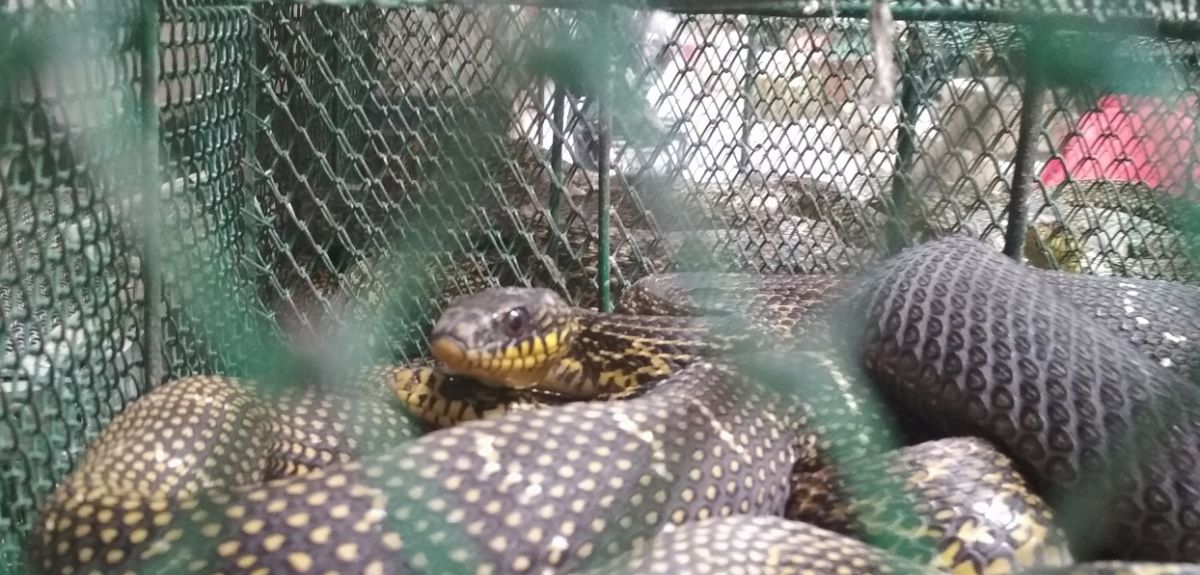
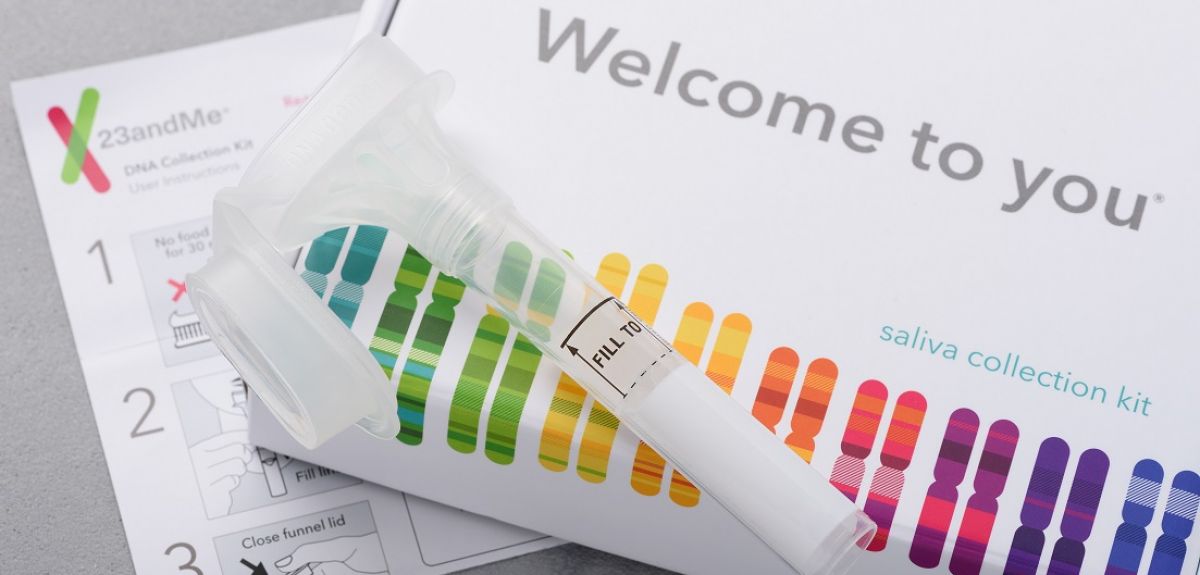
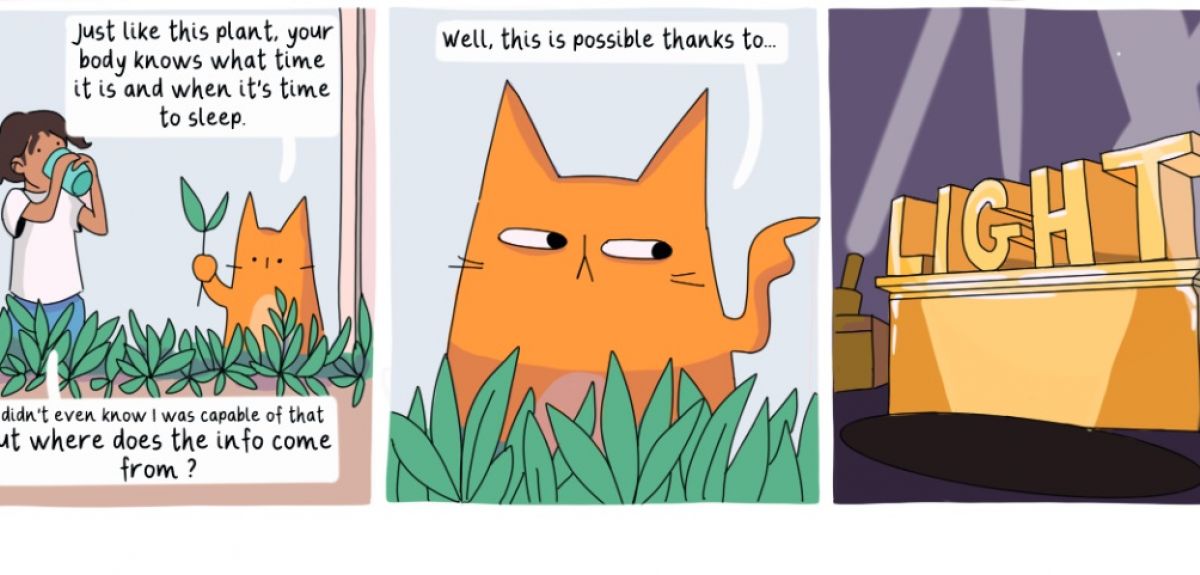
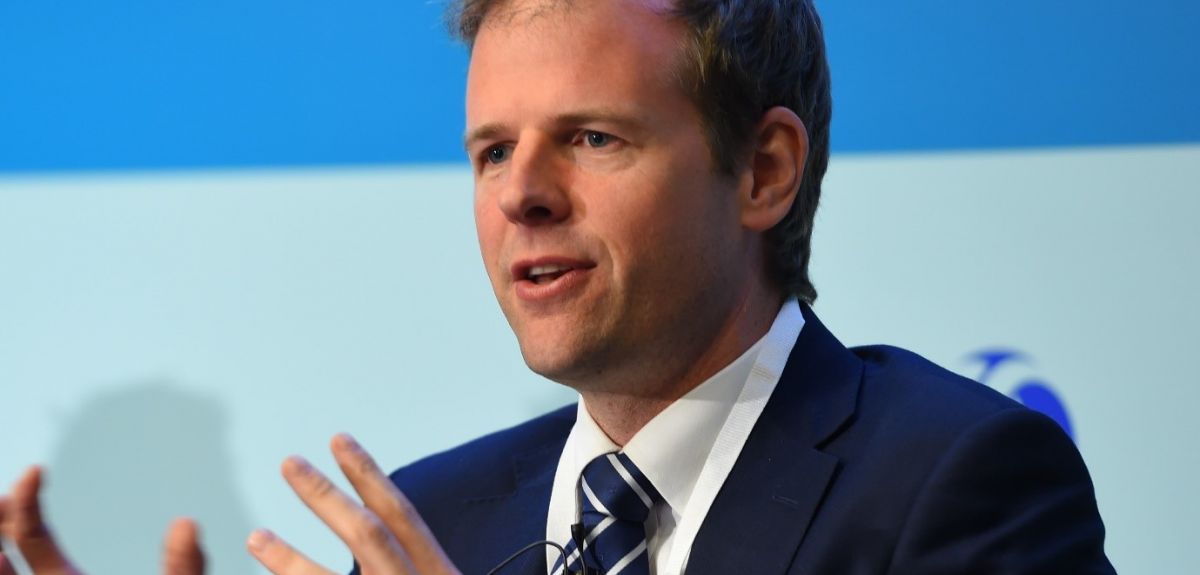
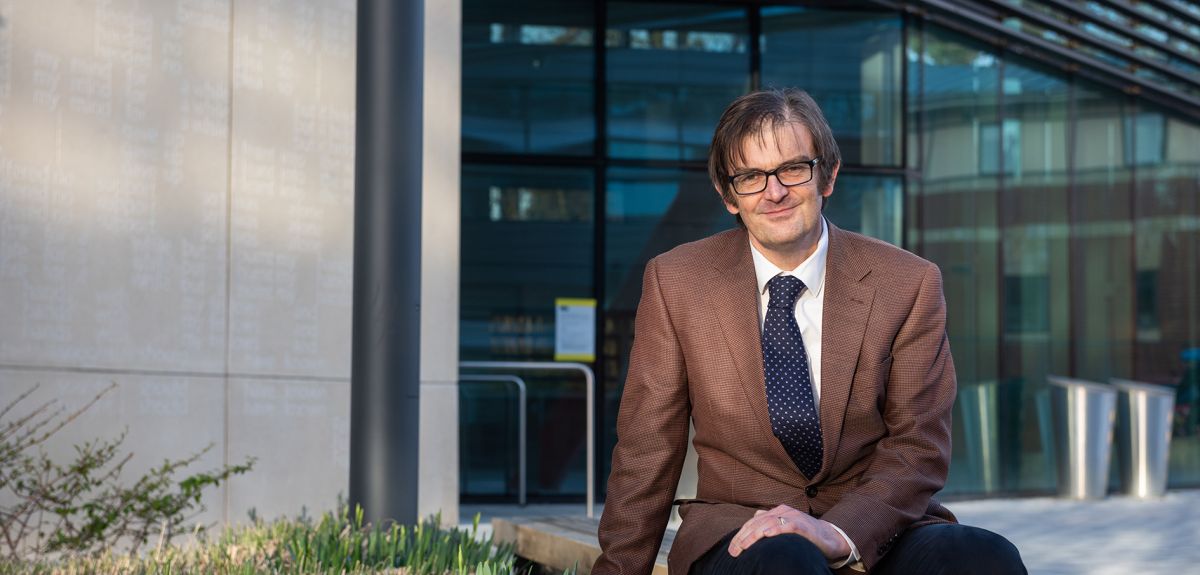
 The Oxford students at the forefront of the fight against microbial resistance
The Oxford students at the forefront of the fight against microbial resistance  The hidden cost of AI: In conversation with Professor Mark Graham
The hidden cost of AI: In conversation with Professor Mark Graham  Astrophoria Foundation Year: Dr Jo Begbie reflects on the programme’s first year
Astrophoria Foundation Year: Dr Jo Begbie reflects on the programme’s first year World Malaria Day 2024: an interview with Professor Philippe Guerin
World Malaria Day 2024: an interview with Professor Philippe Guerin From health policies to clinical practice, research on mental and brain health influences many areas of public life
From health policies to clinical practice, research on mental and brain health influences many areas of public life From research to action: How the Young Lives project is helping to protect girls from child marriage
From research to action: How the Young Lives project is helping to protect girls from child marriage  Can we truly align AI with human values? - Q&A with Brian Christian
Can we truly align AI with human values? - Q&A with Brian Christian  Entering the quantum era
Entering the quantum era Can AI be a force for inclusion?
Can AI be a force for inclusion?